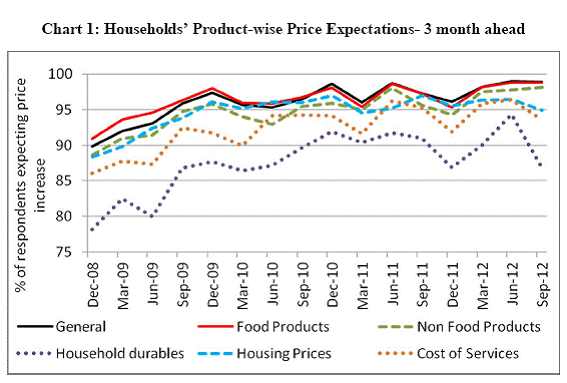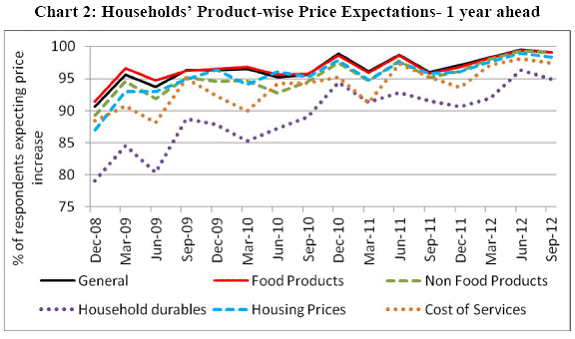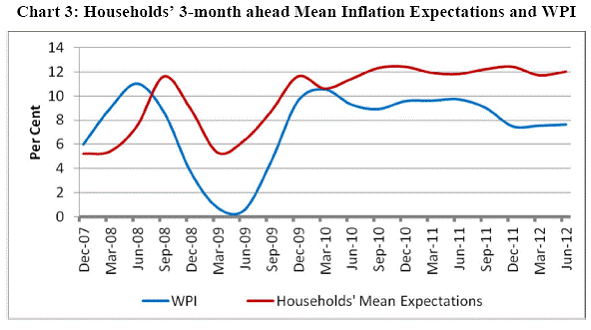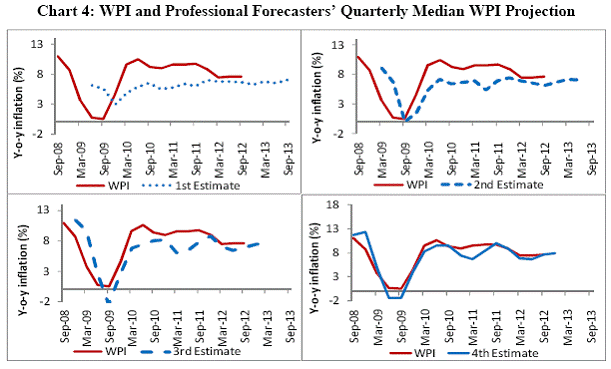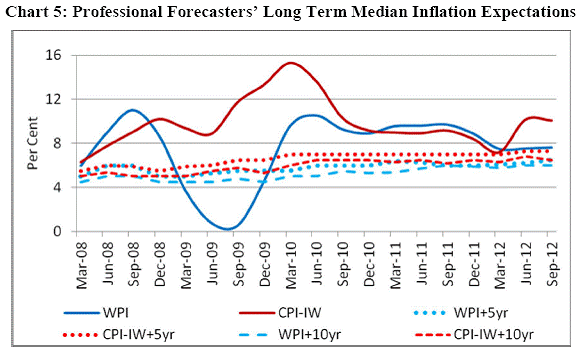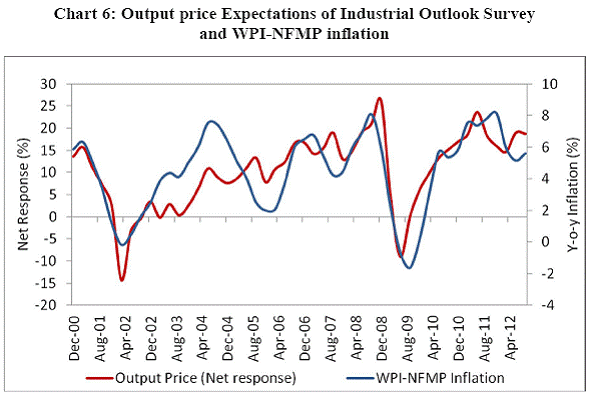The Importance of Inflation Expectations - আৰবিআই - Reserve Bank of India


The Importance of Inflation Expectations
Shri Deepak Mohanty, Executive Director, Reserve Bank of India
delivered-on নৱে 09, 2012
I thank Dr. Sesha Iyer and Dr. Pattnaik for the invitation to address this young audience. In monetary analysis and policy, inflation expectations play a pivotal role. Recently, in many advanced economies, central banks have substantially expanded their balance sheets, which is apparently inflationary. However, central banks in these countries allay the inflation concerns by indicating that, despite substantial monetary easing, medium-term inflation expectations remain well anchored. One inference, therefore, is that inflation in future is unlikely to go up if inflation expectations do not go up. In India, we have the opposite problem: elevated current and expected inflation constrains the Reserve Bank in substantially easing monetary policy. This suggests that central banks, assign a significant weight to inflation expectations in their monetary policy assessment. How does one define “expectations” which is a behavioural and psychological concept and apply it to economics and practical policy making? This is the theme of my talk today. I will sequence my presentation as follows: first, I briefly review the theory and practice of defining inflation expectations; second, discuss the measures of inflation expectations; third, analyse the measures of inflation expectations in India; and finally, conclude with some thoughts on enhancing our understanding of the inflation process and expectations. Theory and Practice Plato defined “expectations” as “the beliefs about the future” more than 2000 years ago which remains valid even today.1 Such beliefs about the future do affect the current behaviour of economic agents. Therefore, inflation expectations can be broadly defined as economic agents’ belief or views or perceptions about inflation in the future. As humans, our minds cannot escape thinking about the future. In a market economy, almost every economic entity is affected by inflation in some way or other. Hence, it is reasonable to surmise that people form their expectations about inflation. The relevant literature identifies two ways of forming inflation expectations. The first is a variant of adaptive behaviour wherein expectations are formed by extrapolating the past and current experience into the future. Apart from the past experience, people do factor in new generally available information. For example, in our case if the monsoon rains are deficient people may expect higher food inflation and, hence, higher overall inflation. At the same time, economic agents learn from their past errors in projecting inflation and take that into account in forming their expectations. However, people may not change their expectations continuously, but may stagger their revisions periodically. The key feature of these variants of inflation expectations is that it is largely backward-looking. The second way of forming inflation expectations in a forward-looking manner is rational expectations. If the economic agents are forming their expectations after processing all available information and also factoring in the reaction function of the monetary authority, it could be considered as rational. In practice, economists derive value of expectations from complex rational expectations models. Empirical evidence, however, suggests that expectations are subject to significant errors, both in its adaptive form and the rational expectations form. In a complex and uncertain world nobody possesses perfect foresight. Even our economy, in which we form expectations, operates with several imperfections. It is not possible to devise an economic model that captures all the relevant variables and at the same time gives accurate predictions about the future. It may thus be reasonable to assume that expectations formation is both a process of adaptive learning and bounded rationality. In terms of practice, a steady and low inflation combined with well-anchored inflation expectations helps the monetary authority in achieving the other objectives of monetary policy – such as economic growth and financial stability. The state of inflation expectations greatly influences actual inflation and, thus, the central bank's ability to achieve price stability. In a paper on inflation expectations, the current US Fed Chairman Ben S. Bernanke explained the term “anchored” to mean relatively insensitive to incoming data.2 That is, if the public experiences a spell of inflation higher than their long-run expectation, and their long-run expectation of inflation changes little as a result, then inflation expectations can be considered as well-anchored. If, on the other hand, the public reacts to a short period of higher-than-expected inflation by marking up its long-run expectation considerably, then expectations are poorly-anchored. Price rises reduce the real purchasing power of individuals. Thus, if inflation is expected to be persistently high, workers bargain for higher nominal wages to protect their real income. This creates a pressure on firms’ costs and they may in turn increase prices to maintain their profits. Independently, the producers’ own inflation expectations also affect inflation directly by influencing their pricing behaviour. If companies expect general inflation to be higher in the future, they may believe that they can increase their prices without suffering a drop in demand for their output3. In economic models with rational expectations, the inflation expectations, and hence inflation itself, is an equilibrium outcome, strongly influenced by the public’s beliefs about the policy rule followed by the central bank. Following this insight from the rational expectations tenet, central banks increasingly communicate their policy reaction function in terms of possible paths for inflation expectations and by establishing inflation targets, attempting to anchor the public’s long-run inflation expectations. Since uncertainty about future inflation affects households’ purchase decision, price stability is described as an environment where economic agents need not take into account uncertainty about future inflation in their decision-making4. Empirical work from advanced countries suggests that, “successful maintenance of price stability requires keeping long-run inflation expectations at the desired level, as economic shocks and policy mistakes come and go”.5 Underscoring the importance of inflation expectations, the Reserve Bank’s Second Quarter Review of Monetary Policy 2012-13 released on 30th October 2012 noted: “A central premise of monetary policy is that low and stable inflation and well-anchored inflation expectations contribute to a conducive investment climate and consumer confidence, which is key to sustained growth on a higher trajectory in the medium-term.” Measurement of Expectations While it is challenging to conceptualise inflation expectations, it is even more difficult to measure it as it cannot be observed in real time. In order to achieve their mandate for low and stable inflation, central banks use several methods to measure the prevailing level of inflation expectations. For this, they seek to gain knowledge about the public’s expectations about inflation in addition to the financial market based measures. The measures used by central banks can thus be broadly classified as market-based measures and survey-based measures. Let me now turn to some of the measurement issues. First, inflation-indexed bond is a market based measure of inflation expectations. It provides protection against inflation. While a conventional bond pays its coupon on a fixed principal amount, the inflation linked bonds provide coupon on inflation-adjusted principal amount. In the recent years, sovereign inflation-indexed bonds have become available in a number of countries and have provided a new instrument for use in retirement saving. The differential yields between ordinary and inflation-indexed government bonds of similar maturity provide an indication of inflation expectations. Second, inflation expectations can also be derived from the yield curve of ordinary bonds of different maturities. The expectations theory implies that the shape of the yield curve depends on the expected pattern of short-term interest rates. The long-term interest rates exceed current short-term rates if short-term rates are expected to rise. The yield curve thus slopes upward. In contrast, long-term interest rates are less than current short-term rates if short-term interest rates are expected to fall. In this case, the yield curve slopes downward. The yield curves can thus be used to gauge inflation expectations. Third, the survey-based approach is the other method of measuring inflation expectations. Surveys can gauge people’s expectations for inflation by simply asking them what they expect. The survey-based methods of measuring inflation expectations are important to policy makers and researchers because they provide data on an otherwise unobservable variable. The surveys cover different target groups ─ usually they pertain to households or professional forecasters. Most of these surveys present both short-term and long-term forecasts on inflation. Fourth, many of the households’ savings and expenditure decisions such as purchasing perishable and durable goods can be affected by expectations and uncertainty about future inflation. Many countries, therefore, conduct consumer surveys to gauge consumer confidence including inflation expectations. In such surveys different sampling techniques such as pure panels and repeat panels are used. Fifth, the Survey of Professional Forecasters (SPF) is another important source to gauge the inflation expectations from analysts. The survey is usually used for forecasting a large variety of macroeconomic variables in addition to inflation, viz., gross domestic product (GDP), interest rates and the unemployment rate. As professional forecasters process large volume of information and rely on econometric models, their forecast of inflation expectations can be considered more rational than that of pure households. Measures of Expectations in India I now turn to issues pertaining to measurement of inflation expectations in India. In the recent years, the Reserve Bank has been assessing the state of inflation expectations in the Indian economy through several means. It conducts a series of surveys aimed at different economic agents as well as model based inflation forecasts (Table 1). These surveys have evolved over time with periodic refinements. Let me give you some perspective on these surveys.
First, the Reserve Bank has been conducting a survey of inflation expectations of households since September 2005 to get a measure of the public pulse on inflation. The initial rounds of the survey were only qualitative in nature and from the 3rd round, questions about expected rate of inflation over the next three months and next one year were added. From the 9th round in September 2007, a question on the respondents’ perception of the prevailing inflation rate was also added. A question on awareness of the public on the RBI’s role to control inflation was added in the 21st round in September 2010. Second, the survey presents a measure of households’ present perception of inflation as well as their expectations about the near future. The inflation expectations survey of households is conducted in twelve cities, three each from the north, south, east and west zones covering the major metros from each zone and eight other cities. The 4,000 respondents are chosen within a city in such a manner that a good geographical and occupational coverage is achieved. The price expectations are sought in the survey for general prices and for five groups: food products, non-food products, consumer durables, housing and services. Third, the Reserve Bank’s consumer confidence survey gives an assessment of the consumer sentiments on prices, as it is an important variable influencing the overall consumer confidence. The overall consumer confidence is assessed on the basis of respondents perceptions of the general economic conditions and their own financial situation. The consumer confidence surveys provide a qualitative measure of consumers’ price expectation. Fourth, the Reserve Bank has been conducting a survey of professional forecasters since 2007. The survey covers forecasters that have an established research set-up and bring out periodic updates on economic developments. These organizations include investment banks, commercial banks, stock exchanges, international brokerage houses, select educational & research institutions, credit rating agencies, securities firms and asset management companies. The schedule covers annual as well as quarterly forecasts of major macroeconomic variables such as, real gross domestic product (GDP), savings and capital formation, select financial market variables, fiscal deficit, policy rates, external sector variables, along with the two key measures of inflation – the wholesale price index (WPI) and the consumer price index for industrial workers (CPI-IW). Importantly, the forecasters are also asked to provide their medium-term (5-years) and long-term (10-years) forecasts of GDP, WPI and CPI-IW. Fifth, apart from the households and the professional forecasters’ inflation expectations, the Reserve Bank captures another measure of inflation expectations ─ those from the producers. These sentiments are captured from a business outlook survey which is being conducted on a quarterly basis since 1998. The survey presents an advance assessment on economic and industrial environment based on the qualitative data collected from select manufacturing companies including their assessment and expectations on the input and output price behaviour. Finally, the results of the above surveys are used as inputs for monetary policy formulation and are placed on RBI website for public dissemination. Salient features of the surveys are also included in the quarterly Macroeconomic and Monetary Developments issued as a companion document to our quarterly policy statements. Trends in expectations Now I turn to evidence on inflation expectations as revealed by various surveys. First, the inflation expectations survey of households seeks information on product-wise price expectations. It can be seen that inflation expectations were dominated by the food price inflation: the prices of food articles drove the sentiment of overall inflation of the households 3-month ahead. The increase in price expectations with regard to household durables was the lowest (Chart 1).
Second, similar trend was also observed for households’ 1-year ahead price expectations (Chart 2). These results are not surprising considering that food has substantial share in the measured relevant price indices: 24.3 per cent in WPI, 35.8 per cent in new (base: 2010 = 100) CPI-urban and 56.6 per cent in new CPI-rural.
Third, the inflation expectations survey of households uses quota sampling to get adequate representation of the gender, occupational categories and age groups. Empirical validation through a bootstrap confidence interval worked out for the overall inflation expectations showed that the width of the confidence interval was quite narrow. Also the size of the confidence intervals increases with the time horizon, indicating that the respondents are more coherent on their perception of the current and very near term (3-months) inflation than their expectations of near future (1-year). Fourth, the inflation expectations of households, however, are their own perceptions based on their own consumption basket which may not directly correspond to any official measure of inflation. This is reflected in significant heterogeneity across households within the survey. However, to see how the average expectations behave compared to the official headline measure of inflation, these expectations have been plotted against WPI inflation. While there is a significant difference in the level of inflation between the headline WPI and the survey, notably households’ 3-month ahead inflation expectations have been, by and large, tracking WPI turning points (ex-post) (Charts 3). This suggests that the households’ inflation expectations are adaptive with significant learning. While households do not revise their expectations unless they see changes on the ground, they are willing to change their expectations with the actual outcome.
Fifth, while the professional forecasters give their immediate term forecast of inflation, it is also an important source of medium- to long-term inflation forecast. The forecast of the professional forecasters can be considered rational as they apparently process all available information including the central bank’s likely reaction function to arrive at their medium- to long-term inflation forecasts. As regards their short-term inflation forecast, as more information becomes available, the forecasters revise their forecasts to incorporate the latest information and the revised quarter ahead forecasts tend to converge to the actual numbers (Chart 4).
Sixth, professional forecasters’ long-run inflation expectations have been influenced by the trend in actual inflation. In the last quarter of 2007-08, the 5-year (10-year) WPI inflation expectations at 5 per cent (4.5 per cent) was aligned to the Reserve Bank’s comfort level. The consumer price (CPI-IW) inflation expectation was slightly higher at 5.5 per cent (5.0 per cent). With the persistence of near double- digit inflation in 2010 and 2011, the medium- and long-term inflation expectations have risen. As per the latest survey conducted in the second quarter of 2012-13, the 5-year (10-year) WPI inflation expectations were higher at 6.5 per cent (6.0 per cent). Similar upward movement in inflation expectations with regard to CPI-IW was also seen. At the same time, the differential between WPI and CPI-IW has also widened underscoring the role of higher food prices in expectations formation (Table 2). Seventh, the inflation expectations were, however, significantly less volatile than corresponding actual rates suggesting that medium- to long-term inflation expectations remained stable, notwithstanding their recent upward movement (Chart 5).
Eighth, the manufacturing companies’ assessment of changes in selling prices for the current quarter and expectations for the ensuing quarter obtained from the industrial outlook survey are well correlated with the year-on-year changes in the price level of non-food manufactured products (NFMP) component of WPI.6 Thus the survey indicators provide good lead information about the movements in the manufacturing price inflation (Chart 6).
Way Forward As I discussed above, the Reserve Bank has developed several measures of inflation expectations over the last seven years which are providing important inputs for monetary policy formulation. In order to reinforce this process, I make a few suggestions. First, the RBI’s inflation expectations survey of households provides a measurement of the sentiment of inflation expectations that is essentially urban. The survey can gradually be extended to semi-urban and rural areas of the country to enhance its representation. But considering the strict time schedule in which the survey needs to be conducted to feed into the quarterly monetary policy process, it may be a difficult task to have a true national representation. Moreover, being too ambitious in the scope and coverage of the survey could dilute its quality. Alternatively, an inflation expectations survey of the households for the rural area can be considered. The sample villages can be drawn from the sampling frame of the new consumer price index-rural. Second, governments in many countries have issued inflation-indexed bonds. These bonds apart from providing the investors a hedge against inflation, give an estimate of inflation expectations. In 1997, India had introduced a variant of inflation- indexed bond where the capital was indexed to inflation. There was no subsequent issue of such bonds due to lack of investor response. Now that we have been through a period of above-trend inflation, the appetite for such bonds may have increased. Further, the issuance of such bonds could signal the firm commitment for containing inflation and thereby, inflation expectations as well. It is, therefore, important that such products be introduced in the Indian debt market to get a pulse of the market based inflation expectations. Third, while there is substantial research on inflation expectations for advanced countries, there is hardly any research in the Indian context. Since the Reserve Bank puts in public domain the results of the various inflation expectations surveys, there is available data base for research in this area. This will not only help improving the quality of the surveys but also will enhance understanding of the process of expectations formulation in the Indian economy. Alongside, financial market variables such as yields and futures prices could be analysed to extract market information about inflation expectations. Conclusion Let me conclude. First, it is clear that peoples’ belief about future inflation is an important factor in shaping inflation trends. But it is not so clear how these inflation expectations are formed: are they formed purely on the basis of past experience or in a forward-looking manner after processing all information or a combination of both? The Reserve Bank’s household expectations surveys suggest that expectations are formed adaptively with learning; but here there is a dominance of food inflation in shaping overall household inflation expectations. Such behaviour of inflation expectations underscores the need for the Reserve Bank to continue to monitor in the Indian context, an array of measures of inflation ─ both overall and disaggregated components, to assess the underlying inflationary pressures. Second, even professional forecasters, who are considered more rational, have moved up their inflation expectations. This suggests that food inflation is acquiring a structural character feeding into inflation expectations: rather than treating higher food prices as a temporary shock, households are assessing this as a permanent structural factor. This has inflationary implications in terms of higher wage-price spiral. If workers’ and producers’ inflation expectations go up than the latter’s demand for wage increases is more likely to be acceded to by the former. If such wage increases are in excess of productivity increase they will be inflationary, making the inflation process persistent and raising the costs of disinflation. Third, in 2007-08, professional forecaster’s medium- to long-term inflation expectations in the range of 4.5-5.5 per cent was well in line with the Reserve Bank’s comfort level and what can be considered growth enhancing threshold level of inflation. Subsequently, as the actual inflation performance has deteriorated, medium- to long-term inflation expectations have also risen to a range of 6.0-7.3 per cent. This underscores the need that the current level of inflation ought to be brought down to better anchor inflation expectations which is vital for maintaining price stability in an enduring manner. * Speech by Deepak Mohanty, Executive Director, Reserve Bank of India at S.P. Jain Institute of Management& Research, Mumbai, 9th November 2012. The assistance by Dr. Praggya Das in preparation of this paper is acknowledged. 1 Curtin, R. (2010), “Inflation expectations and empirical tests”, in Inflation Expectations, Peter Sinclair (eds), Routledge. 2 Bernanke, B. S. (2007); “Inflation Expectations and Inflation Forecasting”, Speech delivered at the Monetary Economics Workshop of the National Bureau of Economic Research Summer Institute, Cambridge, Massachusetts, July 10, 2007. 3 Driver, R. (2007). “Public attitudes to inflation and interest rates”, Quarterly Bulletin Q2, Bank of England (pp 208-223). 4 Greenspan, A. (1996), ‘Opening Remarks’, in Achieving Price Stability, Federal Reserve Bank of Kansas City, Kansas, pp. 1–5. 5 Posen, Adam (2011), ’The soft tyranny of inflation expectations’, Oxonia Distinguished Lecture, Oxford, February 22. 6 For the period December 2000 to September 2012, correlation coefficients at 0.64 and 0.75 respectively for current and ensuing quarters, were statistically significant at 1 per cent level. |
||||||||||||||||||||||||||||||||||||











